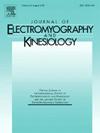Regional differences in behaviors of fascicle and tendinous tissue of the biceps femoris long head during hamstring exercises
Abstract
The biceps femoris long head (BFLH) gains its properties from internal elements (fascicles and tendinous tissues) which behaviors remain poorly understood across BFLH regions and dynamic tasks. The aim of this study was to assess the in vivo behaviors of fascicles and tendinous tissue in the proximal and distal regions of BFLH during different dynamic knee and hip tasks. Twenty males performed the Nordic hamstring exercise (NHE) (n = 9) and Romanian deadlift (RDL) (n = 11). Activation of the BFLH was assessed using surface electromyography signals. Ultrasound images of BFLH and kinematic data were used to estimate the interaction between fascicle and tendinous tissue. The fascicles changed less in length (p < 0.05) and contributed less to BFLH length change (p < 0.05) in NHE with higher activation (p < 0.05) relative to RDL. The higher pennation angle changes of BFLH were found in distal region compared to proximal region in both tasks (p < 0.05), while the activation of distal region was higher than activation of proximal region in NHE (p < 0.05). The BFLH length change was primarily contributed by the tendinous tissue during dynamic resistance tasks, and was contributed less by fascicles which operated more isometrically in knee-dominant NHE with higher activation relative to hip-dominant RDL. Regional differences in pennation angle change and activation during dynamic tasks suggest potential regional differences in the mechanical function of BFLH, warranting further investigation.

 求助内容:
求助内容: 应助结果提醒方式:
应助结果提醒方式:


